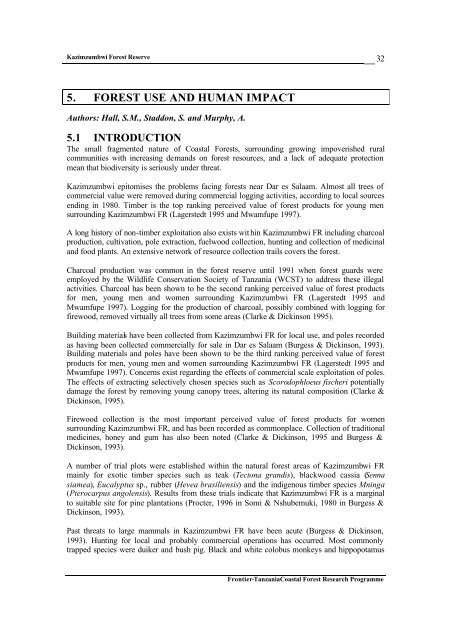Frontier Tanzania Environmental Research REPORT 110 ...
Frontier Tanzania Environmental Research REPORT 110 ...
Frontier Tanzania Environmental Research REPORT 110 ...
Create successful ePaper yourself
Turn your PDF publications into a flip-book with our unique Google optimized e-Paper software.
Kazimzumbwi Forest Reserve<br />
32<br />
5. FOREST USE AND HUMAN IMPACT<br />
Authors: Hall, S.M., Staddon, S. and Murphy, A.<br />
5.1 INTRODUCTION<br />
The small fragmented nature of Coastal Forests, surrounding growing impoverished rural<br />
communities with increasing demands on forest resources, and a lack of adequate protection<br />
mean that biodiversity is seriously under threat.<br />
Kazimzumbwi epitomises the problems facing forests near Dar es Salaam. Almost all trees of<br />
commercial value were removed during commercial logging activities, according to local sources<br />
ending in 1980. Timber is the top ranking perceived value of forest products for young men<br />
surrounding Kazimzumbwi FR (Lagerstedt 1995 and Mwamfupe 1997).<br />
A long history of non-timber exploitation also exists wit hin Kazimzumbwi FR including charcoal<br />
production, cultivation, pole extraction, fuelwood collection, hunting and collection of medicinal<br />
and food plants. An extensive network of resource collection trails covers the forest.<br />
Charcoal production was common in the forest reserve until 1991 when forest guards were<br />
employed by the Wildlife Conservation Society of <strong>Tanzania</strong> (WCST) to address these illegal<br />
activities. Charcoal has been shown to be the second ranking perceived value of forest products<br />
for men, young men and women surrounding Kazimzumbwi FR (Lagerstedt 1995 and<br />
Mwamfupe 1997). Logging for the production of charcoal, possibly combined with logging for<br />
firewood, removed virtually all trees from some areas (Clarke & Dickinson 1995).<br />
Building materials have been collected from Kazimzumbwi FR for local use, and poles recorded<br />
as having been collected commercially for sale in Dar es Salaam (Burgess & Dickinson, 1993).<br />
Building materials and poles have been shown to be the third ranking perceived value of forest<br />
products for men, young men and women surrounding Kazimzumbwi FR (Lagerstedt 1995 and<br />
Mwamfupe 1997). Concerns exist regarding the effects of commercial scale exploitation of poles.<br />
The effects of extracting selectively chosen species such as Scorodophloeus fischeri potentially<br />
damage the forest by removing young canopy trees, altering its natural composition (Clarke &<br />
Dickinson, 1995).<br />
Firewood collection is the most important perceived value of forest products for women<br />
surrounding Kazimzumbwi FR, and has been recorded as commonplace. Collection of traditional<br />
medicines, honey and gum has also been noted (Clarke & Dickinson, 1995 and Burgess &<br />
Dickinson, 1993).<br />
A number of trial plots were established within the natural forest areas of Kazimzumbwi FR<br />
mainly for exotic timber species such as teak (Tectona grandis), blackwood cassia (Senna<br />
siamea), Eucalyptus sp., rubber (Hevea brasiliensis) and the indigenous timber species Mninga<br />
(Pterocarpus angolensis). Results from these trials indicate that Kazimzumbwi FR is a marginal<br />
to suitable site for pine plantations (Procter, 1996 in Somi & Nshubemuki, 1980 in Burgess &<br />
Dickinson, 1993).<br />
Past threats to large mammals in Kazimzumbwi FR have been acute (Burgess & Dickinson,<br />
1993). Hunting for local and probably commercial operations has occurred. Most commonly<br />
trapped species were duiker and bush pig. Black and white colobus monkeys and hippopotamus<br />
<strong>Frontier</strong>-<strong>Tanzania</strong>Coastal Forest <strong>Research</strong> Programme

















